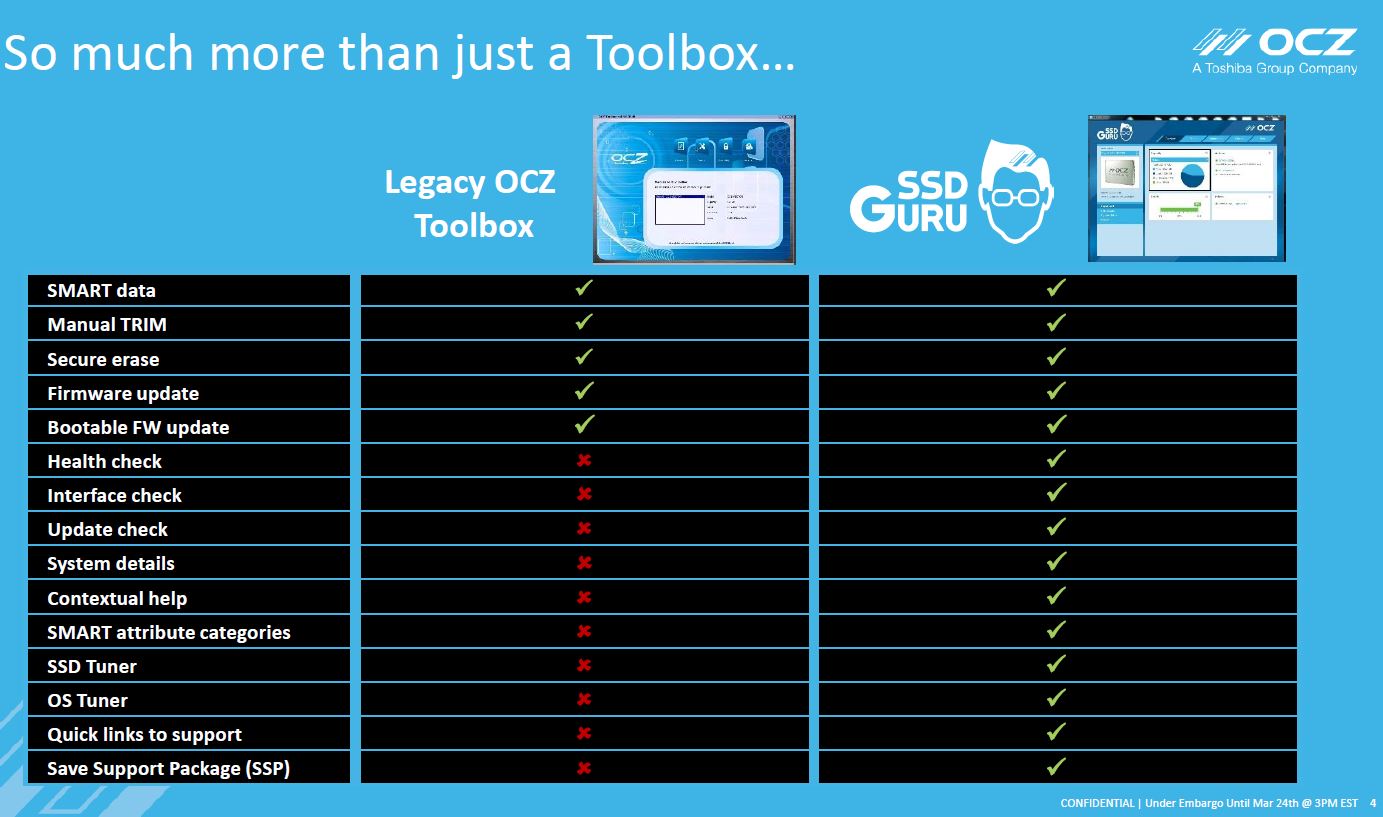

#Ocz ssd utility over provisioning free
If the OP is increased, more free space that is inaccessible by the host can be secured, and the resulting efficiency of GC contributes to improved performance. Random writes, smaller in size than sequential writes, mix valid and invalid pages within blocks, which causes frequent GC and results in decreased performance. What are the advantages of increasing OP? Although there is no difference between the sequential and random write performance for fresh-out-of-the-box (FOB) NAND, the random write does not perform as well as the sequential write once data has been written over the entire space of the NAND. Factory OP Factory OP + User OP Modify OP User Space User Spaceģ How do I calculate the OP ratio? OP Ratio Formula: OP (%) = ((Physical Capacity User Capacity) / User Capacity) * 1 Ex) When 12 GB of a 128 GB SSD is used as the user capacity while 8 GB is assigned to the OP, the OP (%) is ((128 12) / 12) * 1 = 6.7 %. Typically, Samsung DC SSDs are set to provide 6.7% of capacity for OP by default, but the user can manually adjust the size of the space if he or she requires additional OP depending on the user environment.

Consisting of free blocks only, the OP region assists in efficient delivery of free blocks when wear-leveling or garbage collection is in progress and contributes to improved performance and lifetime of the SSD. This space can only be accessed by the SSD s controller and not by the host. Figure 2: Garbage Collection Step1 Collect valid pages Block A Block B Free Block Valid Page Invalid Page Free Page Step2 Erase Blocks consisting of invalid pages ERASE What is OP (over-provisioning)? As previously stated, over-provisioning refers to a function that secures extra space to allow for efficient use of the SSD by allocating a certain amount of the SSD s NAND flash to an over-provisioning space. This process in which extra space is allocated is called over-provisioning (OP). Therefore, free space in the SSD is required to allow the firmware (FW) feature to run smoothly. However, this too may sometimes result in slower performance in the unexpected case that garbage collection interferes with the host write. This technology secures free blocks by collecting valid pages into a single location and erasing the blocks consisting of invalid pages. To alleviate this decrease in write performance, a process called garbage collection (GC) is implemented to create free blocks within the SSD. Generally, it takes longer to erase data than to write it because, as mentioned previously, write operations are carried out in pages while erase operations are executed in blocks. Figure1: Wear Leveling High PE Without Wear-Leveling With Wear-Leveling Low PE Invalid Block Free Block Free Space High EC Low ECĢ Since overwriting is impossible with NAND flash, existing data must first be erased in order to write new data to that cell, which slows down overall write performance of the SSD. Wear-leveling, a function that prevents repeated writing operations to a certain region, enables cells to be utilized evenly by swapping the blocks exposed to a high number of P/E cycles with free blocks, allowing the user to use the SSD longer under given conditions. When data is repeatedly written in a certain area, the corresponding cells quickly wear out, so such repeated writing to the same cells should be prevented. Therefore, proper management of NAND is crucial in extending the lifetime of the SSD. Such a phenomenon is called the wear-out of cells and is responsible for the physical limits of the lifetime of NAND. As more of such cycles are repeated, some electrons get trapped between cells and over time, these cells reach the end of their lifetime and encounter durability issues. Since the writing and erasing operations (Program/Erase) of an SSD are carried out in different units, referred to as pages and blocks respectively, multiple cycles of Program and Erase are inevitable in writing and managing data. With NAND flash, the stored data cannot be overwritten when new data is stored or erased.

Background Unlike Hard Disk Drives (HDDs), Solid State Drives (SSDs) store electrons on NAND cells when writing data.
#Ocz ssd utility over provisioning how to
This white paper provides in-depth information about over-provisioning, as well as instructions on how to adjust the over-provisioning space, and considerations to be made before doing so. The dedicated over-provisioning space may be adjusted to the user s preference, delivering benefits that include faster speed and longer SSD life.

1 White Paper Over-Provisioning Benefits for Samsung Data Center SSDs Over-provisioning is a function that provides additional capacity specifically for data to be erased from an SSD, without interrupting system performance.


 0 kommentar(er)
0 kommentar(er)
